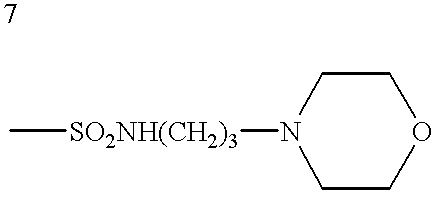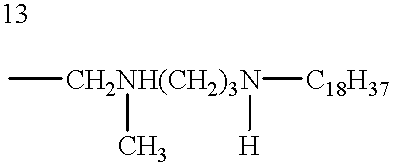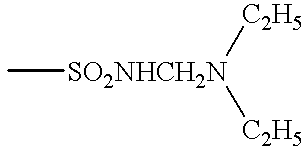Inkjet recording liquid and process for the production thereof
a technology of recording liquid and inkjet, which is applied in the direction of chemistry apparatus and processes, inks, printing, etc., can solve the problems of poor water resistance of inkjet printing, easy blot of printed portions, and general inability to use methods
- Summary
- Abstract
- Description
- Claims
- Application Information
AI Technical Summary
Benefits of technology
Problems solved by technology
Method used
Image
Examples
example 1-1
250 Parts of a quinophthalone pigment ("Pariotol Yellow K0961HD" supplied by BASF), 2,500 parts of sodium chloride and 160 parts of polyethylene glycol (supplied by Tokyo Chemical Industry Co., Ltd.) were charged into a 1-gallon kneader of stainless steel (supplied by Inouesha Seisakusho), and kneaded at 60.degree. C. for 4 hours. Then, the mixture was poured into 2.5 liters of warm water, and stirred with a high-speed mixer under heat around 80.degree. C. for about 1 hour to form a slurry. Then, the filtering of the slurry and the washing thereof with water were repeated five times to remove the sodium chloride and the solvent, whereby a water-based dispersion (treated pigment dispersion) having a solid content of 50% was obtained.
The following materials were placed in a sand mill and dispersed for 4 hours to prepare a concentrated inkjet recording liquid.
After the above materials were dispersed, the following components were mixed. Then, the mixture was filtered through a 1-.mu.m ...
example 1-2
250 Parts of a quinophthalone pigment ("Pariotol Yellow K0961HD" supplied by BASF), 2,500 parts of sodium chloride, 25 parts of a yellow pigment dispersing agent (P-[CH.sub.2 NH(CH.sub.2).sub.4 N(CH.sub.3).sub.2 ].sub.3, P=benzimidazole residue) and 160 parts of polyethylene glycol 300 (supplied by Tokyo Chemical Industry Co., Ltd.) were charged into a 1-gallon kneader of stainless steel (supplied by Inoue Seisakusho), and kneaded at 60.degree. C. for 3 hours. Then, the resultant mixture was poured into 2.5 liters of warm water, and stirred with a high-speed mixer under heat around 80.degree. C. for about 1 hour to form a slurry. Then, the filtering of the slurry and the washing thereof with water were repeated five times to remove the sodium chloride and the solvent, whereby a water-based dispersion (pigment derivative-treated pigment dispersion) having a solid content of 50% was obtained. The following materials were placed in a sand mill and dispersed for 4 hours to prepare a con...
example 1-3
250 Parts of a quinophthalone pigment ("Pariotol Yellow K0961HD" supplied by BASF), 2,500 parts of sodium chloride, 90 parts of "Epikote 1004" (epoxy resin, supplied by Yuka-Shell Epoxy K.K.) and 160 parts of polyethylene glycol 300 (supplied by Tokyo Chemical Industry Co., Ltd.) were charged into a 1-gallon kneader of stainless steel (supplied by Inoue Seisakusho), and kneaded at 600.degree. C. for 3 hours. Then, the resultant mixture was poured into 2.5 liters of warm water, and stirred with a high-speed mixer under heat around 80.degree. C. for about 1 hour to forma slurry. Then, the filtering of the slurry and the washing thereof with water were repeated five times to remove the sodium chloride and the solvent, whereby a water-based dispersion (pigment dispersion treated with epoxy) having a solid content of 50% was obtained.
The following materials were placed in a sand mill and dispersed for 3 hours to prepare a concentrated inkjet recording liquid.
After the above materials wer...
PUM
| Property | Measurement | Unit |
|---|---|---|
| Percent by mass | aaaaa | aaaaa |
| Angle | aaaaa | aaaaa |
| Angle | aaaaa | aaaaa |
Abstract
Description
Claims
Application Information
 Login to View More
Login to View More - R&D
- Intellectual Property
- Life Sciences
- Materials
- Tech Scout
- Unparalleled Data Quality
- Higher Quality Content
- 60% Fewer Hallucinations
Browse by: Latest US Patents, China's latest patents, Technical Efficacy Thesaurus, Application Domain, Technology Topic, Popular Technical Reports.
© 2025 PatSnap. All rights reserved.Legal|Privacy policy|Modern Slavery Act Transparency Statement|Sitemap|About US| Contact US: help@patsnap.com



